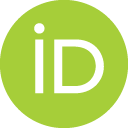What is ORCID ?
ORCiD - Open Researcher and Contributor ID
 A non-profit registry of unique research identifiers; also providing a transparent method of linking research activities and outputs to these identifiers.
A non-profit registry of unique research identifiers; also providing a transparent method of linking research activities and outputs to these identifiers.
ORCiD iD -- Unique, persistent identifier for researchers & scholars
A 16-digit number linked to your ORCID profile and can be submitted along with your manuscript for publication, grant proposal, and other digital dissemination of your work to connect your work with your scholarly identity.
Want help getting started? We recommend you view this recorded ORCiD Workshop
Why do you need an ORCID iD?
- Enhance name disambiguation
- Is not limited by institution/publisher/platform
- Stays with you throughout your career
- Improves discoverability & Connects your work
- Machine actionable mechanisms to link research outputs online to your identity
- Wide range of works can be included
- Is a profile you set up and control, including:
- privacy settings, what is included/displayed
- access to your record from “Trusted Organization” for auto-update
- allowing you to identify & claim your scholarship/publications
- Is open source, responsive to users, active and transparent integration with the scholarly infrastructure
Additional benefit:
Sign in with collaboration tools via one account that connecting all your scholarly work. For examples, sign in Open Science Framework or Overleaf as shown in the screenshots below.
How does ORCID work through the scholarly infrastructure?

It would only work if you, the author / content creator, have an ORCID iD and use it with your research output!
Register and Sign In
- Get your unique ORCID identifier: Register at orcid.org/register
Choose either your mines.edu email or your personal email to register. You can always change your email associated with your ORCID iD if you graduate from or leave Mines.
- You may now use Mines credential to sign in your ORCID profile.


Populate Your ORCID Profile
- Content to add manually
- Biography
- Education
- Employment
Add works
- Search & Link
- Use CrossRef Metadata Search, DataCite, ResearcherID (Web of Science), or Scopus to ORCID to search and import your publications.
- You will need to Authorize the linking.
- Auto-update: Once authorized, the data source will alert you when new works become available. You can decide whether to add the new works to your profile. To ensure you receive the alerts, make sure you check the option for “An ORCID member wants my permission to add or update my ORCID record.” in your Account seting/Email notification setting if you’d like to grant permission to those additions one by one.
 All the authorizations can be revoked in your Account Settings
All the authorizations can be revoked in your Account Settings
- Search & Link
- Import BibTex
- If you have all your publications saved in a reference management software, export them into the ".bib" format and upload it to your ORCID profile.
- If you have your Google Scholar profile cleaned up, you can export the publication list there into a ".bib" file and import it there.
- Add manually by completing a form
- Link between Scopus and ORCID: Scopus2ORCID
- Link between ResearcherID and ORCID: ResearcherID & ORCID Integration
Use Your ORCID iD

- When you submit your manuscript for publishing
- When you apply for grants
- On your webpage
- In your email signature
- When you share data sets, slides, posters, or other project in open repositories (e.g. Open Science Framework, Zenodo, Disciplinary and Institutional Repository etc.)
- When you do peer review or post your peer review activity history (e.g. Publon connecting to ORCID)
Proper display of ORCID iD in your email signature or webpage
Example: a full https URI preceded by the iD icon, both hyperlinked to the URI
.gif) https://orcid.org/0000-0002-1825-0097
https://orcid.org/0000-0002-1825-0097
Download ORCID icon: orcid.org/trademark-and-id-display-guidelines
As shown in the screenshot, from the sidebar of your profile, you can get:
- HTML code to display ORCID on your website
- QR Code for your ID
When you submit a grant application:
-
ORCID integration to SciEnCV for NIH and NSFStep-by-step guide on how to link your SciEnCV to your ORCID
-
ORCID integration to DOE OSTI profileHow to integrate ORCID to DOE OSTI author profile
When you submit a manuscript:
Check your author profile on the publishers' website, find a field to add your ORCID iD to it. The implementation timeline of ORCID integration of various publishers can be found here. If your academic advisor is submitting the manuscript, ask them to add you as co-authors in the system with the email you used to create the author profile. Your linked ORCID iD should show up in the final publication.
Examples of ORCID integration in IEEE and ACS manuscript submission system.

Publishers Require ORCID iD
See the up-to-date list of publishers requiring ORCID iD for corresponding authors at the ORCID site here.
Here, we highlight a few publishers that Mines authors work with frequently.
- American Geophysical Union
- IEEE
- American Chemical Society
- Royal Society of Chemistry
- IOP Publishing
- Wiley
- SpringerNature
- ... ...
Types of Unique and Persistent Identifiers
See a list of persistent identifiers useful in Scholarly Communication complied by National Information Standards Organization.
Here, we highlight a few most useful ones for researchers in science and engineering.
Identifiers for People (e.g. author)
Identifiers for Objects (e.g. articles)
Identifiers for Micro-objects (e.g. molecules)
- CAS registration number
- InChi
- Protein identifier: PDB ID(s)
- Gene ID: GI Numbers


 Add works
Add works
 All the authorizations can be revoked in your Account Settings
All the authorizations can be revoked in your Account Settings